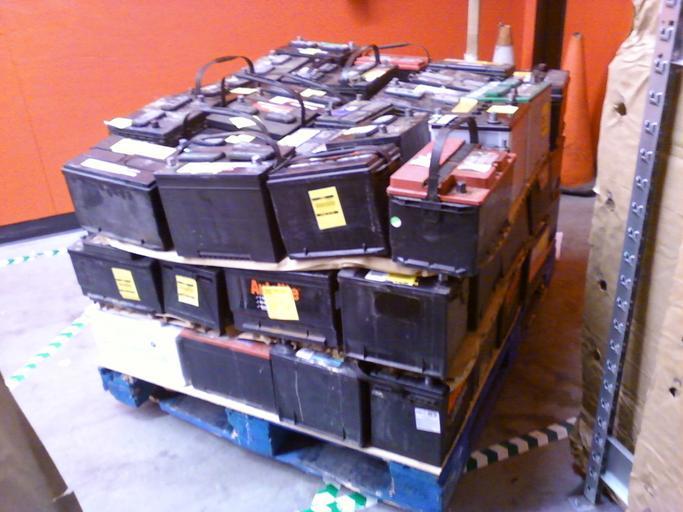
Automotive batteries are regarded as one of the most hazardous materials to use and transport, which is why it is important to be careful when using automotive or car batteries. Therefore, automotive batteries are an example of which hazard class?
Automotive batteries are an example of class 9 miscellaneous hazardous materials in the U.S. and international hazardous materials regulations and are subject to specific packaging, marking, labeling, and shipping paper requirements because they contain materials/chemicals that can harm the user or environment if not properly packaged and disposed of.
Automotive Batteries are an Example of Which Hazard Class?
Automotive batteries are an example of class 9 miscellaneous hazardous materials. They are classified as miscellaneous hazardous materials because they contain materials/chemicals that are capable of harming the environment.
When something is said to be a miscellaneous hazardous material, it means that it contains materials that possess anesthetic, noxious, and other properties that can cause extreme damage or discomfort to the environment.
Other materials that contain miscellaneous hazardous materials are:
- Battery powered equipment
- Aerosols and lighters.
- Corrosives.
- Dry ice.
While this is noted, it’s also important to avoid any product that contains miscellaneous hazardous materials or at least be most careful when using and disposing of them to avoid causing harm to you. That is why automotive batteries are handled with care.
Transporting of Automative Batteries Under Class 9
Since automotive batteries are examples of class 9 miscellaneous hazardous materials, it is important they are transported properly.
The Pipeline and Hazardous Materials Safety Administration (PHMSA) (a sub-agency of The U.S. Department of Transportation (DOT) is the body responsible for making available the required transportation and disposable regulation of these hazardous materials.
According to them, the batteries or anything that can cause dangerous heat or generate a spark are subject to 49 CFR 173.21(c) in the U.S. hazardous materials regulations and should not be transported unless packaged carefully/properly in a way that it won’t cause any harm.
This is to say that if you are transporting automotive batteries and batteries with lead acid, you should ensure that the batteries are packaged carefully/properly. Under no circumstances should you carelessly transport any of those batteries under class 9 else you will be penalised.
According to (PHMSA) and (DOT), failure to abide by this rule is a violation of the U.S. hazardous materials regulations which will attract civil penalties.
When these batteries are transported internationally, they should be packaged in accordance with the International Civil Aviation Organization (ICAO) Technical Instructions and corresponding International Air Transport Association (IATA) Dangerous Goods Regulations, and the International Maritime Dangerous Goods (IMDG) Code.
The person transporting the batteries should also consider Canada’s Transport of Dangerous Goods Regulations (TDGR), and the European Agreement concerning the International Carriage of Dangerous Goods by Road (ADR).
As reiterated earlier, it is a DOT violation not to properly transport the batteries the recommended or required way, therefore, if as a shipper, you do not fully understand the requirements, you are urged to consult with hazardous materials regulatory experts who will explain all you need to know for a better understanding.
However, when transporting automotive batteries, you must ensure that:
- The batteries are securely packaged in a manner that prevents the generation of a dangerous quantity of heat.
- It is packed to avoid damage caused by shifting or placement within the package
- It is packaged to avoid accidental activation of the equipment. Generally, the battery should be packaged securely. It should be packaged in strong outer packaging.
- The batteries are protected against short circuits
- The batteries are able to withstand vibrations and pressure differential rest
- The batteries are not leaking fluid
- The battery terminals must be separated from each other and must not touch each other
- The battery terminals must be covered
Disposing of Automative Batteries Under Class 9
Just like the transportation of automotive batteries under class 9 miscellaneous hazardous materials, it’s important they are disposed of properly. Therefore, when disposing of these batteries, ensure they are:
- Properly packaged
- The battery terminals should not be open and allowed to touch each other
- It must be labeled as hazardous materials on the package
- The UN Number must be written boldly on the packaging of the disposing battery
- You should also include the proper description of the material
- The batteries should be taken to where they are equipped to properly dispose of such as a battery retailer or local hazardous waste collection program, etc.
What is the Best Battery Classification to be Used for Automotive?
The best battery classification to be used for automotive is the Lithium Ion battery because they are strong, efficient, and durable. Lithium Ion batteries are known for their good high-temperature performance. Other features of this battery include low self-discharge, high energy efficiency, and a high power-to-weight ratio.
Conclusion
Automotive batteries have always been regarded as hazardous and should be handled with caution during the production, packaging, transportation, and disposal of the battery. Since automotive batteries are an example of class 9 miscellaneous hazardous materials in the U.S. and international hazardous materials (dangerous goods) regulations, failure to abide by or follow the recommended packaging and transportation rules is a DOT violation that attracts civil penalties.









